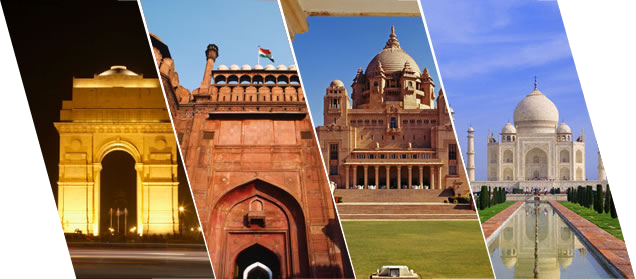After breakfast pick up from Your Hotel and start a sightseeing tour of Delhi. Delhi has divided by two parts Old Delhi and New Delhi. First visit the old Delhi. Red Fort The Red Fort Complex was built as the palace fort of Shahjahanabad - the new capital of the fifth Mughal Emperor of India, Shah Jahan. Named for its massive enclosing walls of red sandstone, it is adjacent to an older fort, the Salimgarh, built by Islam Shah Suri in 1546, with which it forms the Red Fort Complex. The private apartments consist of a row of pavilions connected by a continuous water channel, known as the Nahr-i-Behisht (Stream of Paradise). The Red Fort is considered to represent the zenith of Mughal creativity which, under the Shah Jahan, was brought to a new level of refinement. The planning of the palace is based on Islamic prototypes, but each pavilion reveals architectural elements typical of Mughal building, reflecting a fusion of Persian, Timurid and Hindu traditions The Red Fort's innovative planning and architectural style, including the garden design. Jamia Mosque It was known as central mosque of the old delhi in the time of shah jahan.He completed this mosque in the year 1656 and made it the biggest and best known mosque all over India.The name of Jama Masjid was put on the Friday noon prayer which used to given at this mosque. The capacity of this mosque is about 25000 people which are more than any other mosque in India. The history of Jama Masjid included the blood shielding work of about 5000 labors for making this mosque. The cost of this mosque at the time period of Shah Jahan was estimated to be about 1 million rupees. Raj Ghat A simple square platform of black marble marks the spot where Mahatma Gandhi was cremated following his assassination in 1948. It is surrounded by a beautiful park with labeled trees planted by notables like Queen Elizabeth II, USA President Eisenhower, Ho Chi Minh and various others. Two museums dedicated to Gandhi ji are nearby. After visit the Old Delhi visit the New Delhi India Gate The foundation stone of India Gate was laid by His Royal Highness, the Duke of Connaught in 1921 and it was designed by Edwin Lutyens. The monument was dedicated to the nation 10 years later by the then Viceroy, Lord Irwin. Another memorial, Amar Jawan Jyoti was added much later, after India got its independence. The eternal flame burns day and night under the arch to remind the nation of soldiers who laid down their lives in the Indo-Pakistan War of December 1971. President House home to the President of the world's largest democracy, is emblematic of Indian democracy and its secular, plural and inclusive traditions. It was designed by Sir Edwin Lutyens and Herbert Baker and stands on a 330 acre estate. It took seventeen years to build this presidential palace which was completed in the year 1929. Almost seven hundred million bricks and three million cubic feet of stone were used in building this architectural marvel that has 2.5 kilometers of corridors and 190 acres of garden area. The main building covers an area of 5 acres and has 340 rooms spread over four floors. The famous Mughal Gardens of the Rashtrapati Bhavan cover an area of 15 acres and have 159 celebrated varieties of roses, 60 varieties of bougainvillea and many other verities of flowers. Humayun's Tomb Humayun's Tomb, Delhi is the first of the grand dynastic mausoleums that were to become synonyms of Mughal architecture with the architectural style reaching its zenith 80 years later at the later Taj Mahal. Humayun's Tomb stands within a complex of 21.60 ha. that includes other contemporary, 16th century Mughal garden-tombs such as Nila Gumbad, Isa Khan, Bu Halima, Afsarwala, Barber's Tomb and the complex where the craftsmen employed for the Building of Humayun's Tomb stayed, the Arab Serai. Lotus Temple Lotus temple is built in the shape of a lotus flower and is the last of seven Major Bahai's temples built around the world. Completed in1986 it is set among the lush green landscaped gardens. The structure is made up of pure white marble The architect Furiburz Sabha chose the lotus as the symbol common to Hinduism, Buddhism, Bhai Temple Jainism and Islam. Adherents of any faith are free to visit the temple and pray or meditate. Qutub Minar Built in the early 13th century a few kilometers south of Delhi, the red sandstone tower of Qutb Minar is 72.5 m high, tapering from 2.75 m in diameter at its peak to 14.32 m at its base, and alternating angular and rounded flutings. The surrounding archaeological area contains funerary buildings, notably the magnificent Alai-Darwaza Gate, the masterpiece of Indo-Muslim art (built in 1311), and two mosques, including the Quwwatu'l-Islam, the oldest in northern India, built of materials reused from some 20 Brahman temples. Lakshmi Narayan Temple Laxmi Narayan Temple, also known as Birla Mandir, is one of Delhi's major temples and a major tourist attraction. Built by the industrialist Sh. J.K. Birla in 1939, this beautiful temple is located in the west of Connaught Place. Birla Mandir The temple is dedicated to Laxmi (the goddess of prosperity) and Narayana (The preserver). The temple was inaugurated by Mahatma Gandhi on the condition that people of all castes will be allowed to enter the temple. Evening transfer to your Hotel.



Tour Reviews
There are no reviews yet.
Leave a Review